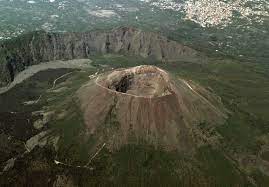Mt Vesuvius:

Researchers deciphered ancient scroll buried in the ashes of Mount Vesuvius with the help of artificial intelligence.
- Mt. Vesuvius is an active volcano that rises above the Bay of Naples on the plain of Campania in southern Italy.
- It is the only active volcano in mainland Europe.
- The volcano is classified as a complex stratovolcano because its eruptions typically involve explosive eruptions as well as pyroclastic flows.
- A pyroclastic flow is a high-density mix of hot lava blocks, pumice, ash, and volcanic gas.
- It is most famous for the 79 AD eruption that destroyed the Roman cities of Pompeii and Herculaneum.
- It is part of the Campanian volcanic arc, a line of volcanoes that formed over a subduction zone created by the convergence of the African and Eurasian plates.
- This subduction zone stretches the length of the Italian peninsula and is also the source of other volcanoes like Mount Etna, the Phlegraean Fields (Campi Flegrei), Vulcano, and Stromboli.
- Under Vesuvius, the lower part of the subducting slab has torn and detached from the upper part to form what is called a “slab window.”
- This makes Vesuvius’ rocks slightly different chemically from the rocks that erupted from the other Campanian volcanoes.




